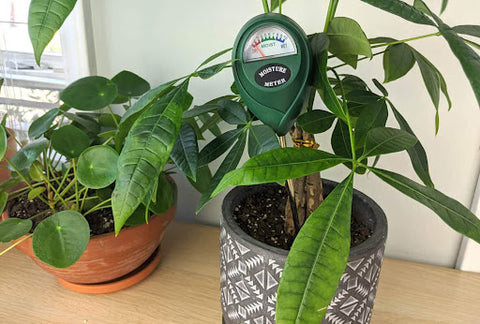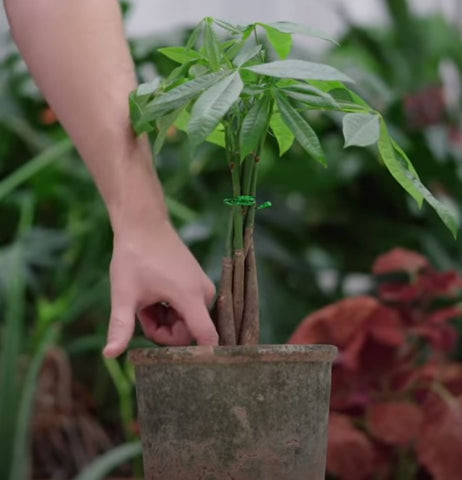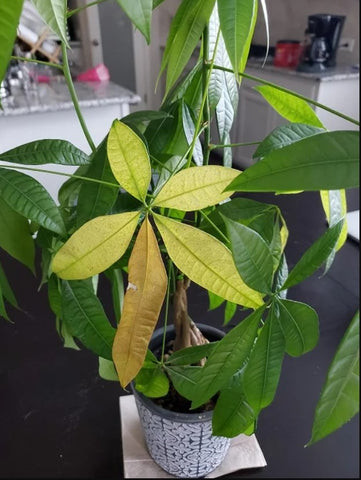Money Trees, scientifically known as Pachira Aquatica, are more than just attractive houseplants with their distinctive braided trunks and vibrant green leaves. They are symbols of good fortune and prosperity, deeply rooted in Feng Shui traditions, making them a popular choice for homes and offices alike. One of the most common questions for both novice and experienced plant owners is, How Often To Water Money Tree to ensure it thrives. Understanding the right watering techniques is crucial for maintaining a healthy and vibrant money tree. This comprehensive guide will walk you through everything you need to know about watering your money tree correctly, helping you cultivate a lush and lucky plant.
Understanding Your Money Tree’s Watering Needs
Native to the humid environments of Central and South America, money trees are accustomed to conditions that mimic tropical rainforests. In their natural habitat, they experience periods of heavy rainfall followed by drier spells. To successfully grow a money tree indoors, it’s essential to replicate this natural cycle, especially when it comes to watering. The key principle to remember is that money trees prefer deep, infrequent watering, allowing the soil to dry out somewhat between each session. This approach imitates the natural rainfall patterns they are used to and prevents the common problem of overwatering, which can be detrimental to their health. Before you even think about reaching for your watering can, ensure the soil is adequately dry. This single step is the foundation of proper money tree hydration.
Step-by-Step Watering Methods for Your Money Tree
There are several effective methods for watering your money tree, each with its own set of advantages. Understanding these techniques will empower you to choose the best approach for your plant and lifestyle.
Over-the-Soil Watering: The Classic Approach
 Watering Money Tree Over Soil
Watering Money Tree Over Soil
This is perhaps the most common and straightforward method for watering a money tree. Here’s a detailed step-by-step guide:
- Prepare Your Water: Always use room temperature water. Cold water can shock the roots of your money tree. If your tap water is heavily chlorinated, let it sit out in an open container for 24 hours to allow the chlorine to dissipate. This is a simple step that can significantly benefit your plant’s health.
- Assess Soil Moisture: Before watering, it’s crucial to check the moisture level of the soil. Insert your finger about 2-4 inches deep into the soil. If the soil feels dry to the touch at this depth, it’s time to water. You can also use a moisture meter for a more precise reading, especially if you are unsure.
- Position for Drainage: Move your money tree to a sink, bathtub, or place it in a basin or large saucer. This is essential to catch any excess water that drains out from the bottom of the pot and prevent water damage to your surfaces.
- Watering Technique: Slowly and evenly pour water over the entire surface of the soil. Continue watering until you see water beginning to drain out from the drainage holes at the bottom of the pot. Ensure you are saturating all of the soil, not just one area.
- Drain Excess Water Thoroughly: Allow the excess water to drain completely. Let the pot sit for about 15-30 minutes to ensure all excess water has drained. Standing water can lead to root rot, a common issue for money trees.
- Watering Frequency: Repeat this watering process only when the top inch or two of soil feels dry again. This could be anywhere from every one to three weeks, depending on environmental factors which we will discuss later. Avoid watering on a strict schedule; always check the soil moisture first.
Consistency is key to successful over-the-soil watering. By following these steps, you’ll be well on your way to providing your money tree with the hydration it needs.
Bottom Watering Your Money Tree: Encouraging Deep Root Hydration
Bottom watering is an excellent alternative method that encourages the roots to grow downwards in search of moisture, leading to a stronger and healthier root system. It also minimizes the risk of overwatering and keeps the foliage dry, reducing the chance of fungal issues.
- Select a Saucer: Choose a saucer or shallow dish that is wider than the base of your money tree’s pot and can comfortably hold it.
- Place the Pot in the Saucer: Set your money tree pot directly into the saucer.
- Add Water to the Saucer: Pour room-temperature water into the saucer. Add enough water to come up about 1-2 inches up the sides of the pot. You don’t want to submerge the entire pot, just enough water for the soil to absorb from the bottom.
- Allow Absorption: Let the money tree pot sit in the water-filled saucer for approximately 30-45 minutes. This allows the soil to draw water up through the drainage holes and thoroughly hydrate from the bottom up. You’ll notice the topsoil becoming moist as the water is absorbed.
- Remove Excess Water: After the soaking period, check if there is any water remaining in the saucer. If there is, carefully pour it out. Leaving the pot sitting in water after it has absorbed enough can lead to over-saturation.
- Watering Frequency: As with over-the-soil watering, repeat the bottom-watering method only when the top 2-4 inches of soil feel dry. Typically, this will be every few weeks.
Bottom watering is a particularly effective method for money trees as it ensures deep hydration and reduces the risk of surface mold or fungal growth.
Watering a Money Tree with Ice Cubes: Convenience with Caution
Watering with ice cubes is sometimes suggested as a convenient method, particularly for smaller houseplants. However, while seemingly simple, it requires a bit of caution with money trees.
To water a money tree with ice cubes, a general guideline is to use about 2-3 ice cubes per week for a 5-inch pot. Place the ice cubes directly on the soil surface, distributing them around the base of the plant, away from the trunk itself. As the ice cubes melt slowly, they release water into the soil gradually.
Important Considerations When Using Ice Cubes:
- Chilling Injury: Money trees are sensitive to chilling temperatures. Never place ice cubes directly on the trunk or leaves of the plant, as this can cause cold damage or “chilling injury.” Always place them on the soil surface.
- Water Distribution: Ensure the melted ice water is distributed evenly throughout the pot. If you only place ice cubes in one spot, you might not be watering the entire root system effectively.
- Humidity Boost: Melting ice cubes can also slightly increase the humidity around the plant as the water evaporates, which can be beneficial for money trees, especially in dry indoor environments. However, this effect is minimal.
- Not a Primary Method: While ice cubes can be used occasionally, they are generally not the most efficient or reliable primary watering method for money trees, especially larger ones. Over-the-soil or bottom watering are more effective in ensuring thorough and consistent hydration.
Using ice cubes can be a supplementary technique, perhaps useful for maintaining humidity or providing a small amount of water between more thorough watering sessions. However, for consistent and deep hydration, stick to over-the-soil or bottom watering methods.
Best Watering Practices for Healthy Money Tree Growth
 Best Watering Practices for Money Tree
Best Watering Practices for Money Tree
To truly master money tree care, it’s essential to go beyond just the mechanics of watering and understand the best practices that will keep your plant thriving.
Recognizing the Signs: When Your Money Tree is Thirsty
Your money tree will communicate its needs to you if you know what signs to look for. Being observant of your plant’s visual cues is often the best indicator of when it needs water.
- Drooping Leaves and Stems: This is one of the most obvious signs. If you notice the usually upright stems and leaves of your money tree starting to droop or sag, it’s a strong indication that the plant is dehydrated.
- Leaf Curl or Crisp Edges: In more severe cases of underwatering, the leaves may begin to curl inwards or develop brown, crispy edges. This signifies that the plant is losing moisture faster than it’s receiving it.
- Lightweight Pot: Pick up your money tree’s pot. If it feels significantly lighter than usual, it could mean the soil is dry and it’s time to water.
- Dry Soil (Top Inches): As mentioned before, always check the soil moisture. If the top 2 inches of soil feel dry to the touch when you insert your finger, it’s time to water. This is a more reliable indicator than just relying on visual cues.
- Soil Pulling Away from Pot Sides: In extremely dry conditions, you might notice the soil pulling away from the sides of the pot. This creates a gap and indicates very dry soil.
While drooping leaves can also be a sign of overwatering, it’s crucial to always check the soil moisture first to differentiate between the two.
Crafting a Money Tree Watering Schedule: Flexibility is Key
While many plant care guides suggest rigid watering schedules, with money trees, flexibility is paramount. There’s no one-size-fits-all answer to how often should I water my money tree, as the frequency depends on various environmental factors.
- General Guideline: A general rule of thumb is to water your money tree approximately once every 1 to 2 weeks. However, this is just a starting point and should be adjusted based on your specific conditions.
- Seasonal Adjustments: During the active growing season (spring and summer), your money tree will generally require more frequent watering as it’s actively growing and using more water. In the dormant season (fall and winter), growth slows down significantly, and the plant needs much less water. Reduce watering frequency in winter, potentially to once every 2-3 weeks or even longer, always checking the soil dryness.
- Environmental Factors:
- Light: Plants in brighter light conditions will dry out faster than those in lower light and will need more frequent watering.
- Temperature and Humidity: Higher temperatures and lower humidity levels will cause the soil to dry out more quickly, necessitating more frequent watering. Conversely, in cooler, more humid conditions, watering can be less frequent.
- Potting Mix: Well-draining potting mixes will dry out faster than denser mixes.
- Pot Material: Terracotta pots are porous and allow moisture to evaporate faster than plastic or glazed ceramic pots.
- Plant Size and Pot Size: Larger plants and smaller pots may require more frequent watering, while smaller plants in larger pots can retain moisture for longer.
Instead of sticking to a fixed schedule, develop a routine of checking the soil moisture every few days and water only when needed. This “check and water when dry” approach is the most effective way to meet your money tree’s hydration needs.
How Much Water to Give: Aim for Thorough Saturation
Determining the amount of water to give your money tree is as important as the frequency. The goal is to thoroughly saturate the soil each time you water, ensuring that water reaches the entire root system.
- Water Until Drainage: The best way to gauge the correct amount is to water until you see excess water draining out of the drainage holes at the bottom of the pot. This indicates that the soil is fully saturated.
- Approximately 20% Runoff: A good rule of thumb is to aim for about 10-20% of the water you pour in to drain out the bottom. This ensures thorough watering and helps to flush out any accumulated salts in the soil.
- Avoid Small Sips: Avoid giving your money tree only small sips of water. This can lead to surface roots developing and the deeper roots not getting enough moisture, making the plant more susceptible to drought stress.
- Adjust Based on Pot Size: Larger pots will naturally require more water to achieve saturation compared to smaller pots.
Watering thoroughly but infrequently is the ideal approach. This encourages deep root growth, making your money tree more resilient and healthy.
Misting Money Tree Leaves: Boosting Humidity and Leaf Health
Money trees thrive in environments with higher humidity, mimicking their native tropical habitat. While not a substitute for watering the soil, misting the leaves can be a beneficial practice, especially in dry indoor conditions, particularly during winter months when indoor heating systems are running.
-
Benefits of Misting:
- Increases Humidity: Misting helps to temporarily increase the humidity around the plant, which money trees appreciate.
- Cleans Leaves: Misting and gently wiping the leaves with a soft cloth can help remove dust and debris, allowing the leaves to photosynthesize more efficiently.
- Simulates Natural Dew: Misting can mimic the morning dew they would experience in their natural tropical environment.
-
How to Mist:
- Use a fine-mist spray bottle filled with distilled water or rainwater. Tap water can leave mineral spots on the leaves over time.
- Mist the leaves lightly, aiming for a fine spray that covers the foliage without making it soaking wet.
- Mist in the morning so that the leaves have time to dry throughout the day, reducing the risk of fungal diseases.
- Mist several times a week, especially in dry conditions.
-
Neem Oil for Pest Prevention: You can add a small amount of neem oil to your misting water (follow product instructions for dilution). Neem oil is a natural insecticide and fungicide that can help prevent pests and fungal issues on your money tree.
Misting is a supplementary care practice that can contribute to the overall health and vitality of your money tree, especially when combined with proper watering techniques.
Special Watering Considerations: Adapting to Environmental Factors
 Special Watering Considerations for Money Tree
Special Watering Considerations for Money Tree
Beyond the basic techniques, several environmental factors significantly influence your money tree’s watering needs. Understanding these special considerations will allow you to fine-tune your watering routine for optimal plant health.
-
Light Exposure and Watering Frequency: The amount of light your money tree receives directly impacts its water requirements. Money trees thrive in bright, indirect light. If your plant is placed in a location that receives a lot of bright, indirect sunlight, it will likely need more frequent watering as the light encourages photosynthesis and water evaporation from the soil. Conversely, money trees in lower light conditions will need less frequent watering as they will use water at a slower rate. Be cautious about direct sunlight, which can scorch the leaves and also dry out the soil very quickly.
-
Plant and Pot Size Dynamics: The relationship between the size of your money tree and its pot also plays a role in watering.
- Small Pot, Larger Plant: If your money tree is root-bound in a small pot, it will dry out much faster and require more frequent watering. The limited soil volume cannot hold much moisture.
- Large Pot, Smaller Plant: In contrast, if a small money tree is planted in a very large pot, the soil will retain moisture for longer, and you will need to water less frequently to avoid overwatering.
- Ideal Pot Size: When the pot size is appropriately matched to the plant’s size, you can saturate the soil fully during watering, and the watering frequency will align with the general guidelines (checking soil dryness).
-
Climate: Temperature and Humidity’s Impact: Your local climate and indoor environment significantly affect how often to water money tree.
- Temperature: In warmer temperatures, water evaporates from the soil more quickly, and the plant may transpire more, requiring more frequent watering. In cooler temperatures, the opposite is true.
- Humidity: Money trees prefer humidity levels of at least 50%. In dry climates or during dry seasons (like winter with indoor heating), the air can draw moisture from the soil and the plant, leading to a need for more frequent watering and possibly misting. In humid climates, the soil will retain moisture longer, and watering can be less frequent.
-
Soil Composition: Drainage is Key: The type of potting mix you use is critical for proper watering. Money trees need well-draining soil to prevent root rot. A sandy-peat-based potting mix is often recommended because it provides good drainage while retaining enough moisture. Heavy, dense soils that retain too much water should be avoided.
-
Watering After Repotting: Repotting is a crucial part of money tree care.
- Water Before Repotting: Water your money tree thoroughly 2-3 days before you plan to repot it. This hydrates the plant and makes it easier to remove from its old pot.
- Water After Repotting: After repotting into fresh soil, water your money tree generously until water drains from the drainage holes. This helps settle the soil around the roots and provides the plant with necessary hydration after the stress of repotting.
By considering these special factors, you can tailor your watering strategy to your money tree’s specific needs and environment, promoting optimal health and growth.
Money Tree Watering Problems and Solutions: Troubleshooting Common Issues
 Money Tree Watering Problems and Solutions
Money Tree Watering Problems and Solutions
Even with the best intentions, watering issues can arise. Recognizing and addressing these problems promptly is crucial to keeping your money tree healthy. The two most common watering-related issues are overwatering and underwatering.
Identifying Overwatering in Money Trees: Signs to Watch For
Overwatering is a more frequent and often more damaging problem for money trees than underwatering. It leads to root rot and other fungal diseases. Learn to recognize the signs of an overwatered money tree:
- Yellowing Leaves: Yellow leaves, especially those that start from the bottom of the plant and progress upwards, are a common sign of overwatering.
- Wilting Leaves (Despite Moist Soil): Ironically, overwatered plants can also wilt. This is because the roots are suffocating and unable to take up water, even though the soil is wet.
- Brown Leaf Tips and Edges: While crispy brown edges can indicate underwatering, soft, mushy brown tips and edges are often a sign of overwatering.
- Brown Spots on Leaves: Irregular brown spots on the leaves can also be a symptom of overwatering.
- Soft, Mushy Stem Base: The base of the stem near the soil line might become soft and mushy to the touch, indicating root rot.
- White Powdery Mold on Soil Surface: The presence of white or grayish powdery mold on the soil surface is a strong indicator of consistently overly moist conditions.
- Foul Odor from Soil: A bad, swampy smell emanating from the soil is a definitive sign of root rot caused by overwatering.
- Dark, Mushy Roots: If you gently remove the plant from its pot, you might observe dark brown or black, mushy, and foul-smelling roots instead of firm, healthy white or tan roots.
- Leaf Drop: Excessive leaf drop, especially of green leaves, can also be a sign of stress from overwatering.
If you observe several of these symptoms, especially in combination, suspect overwatering as the culprit.
Solutions for Overwatered Money Trees: Remedial Actions
If you catch overwatering early, you can often save your money tree. Here’s how to address it:
- Stop Watering Immediately: The first and most crucial step is to stop watering your money tree and allow the soil to dry out significantly.
- Improve Drainage: Ensure your pot has adequate drainage holes. If not, consider repotting into a pot with better drainage.
- Repot with Fresh, Dry Soil: Gently remove the money tree from its pot and carefully remove as much of the soggy soil from the roots as possible without damaging them. Repot the plant into a clean pot with fresh, well-draining potting mix.
- Treat Root Rot (If Present): Inspect the roots for signs of root rot (dark, mushy, smelly roots). If root rot is present, prune away the affected roots with sterile pruning shears. You can also treat the remaining healthy roots with a fungicide solution to prevent further fungal growth.
- Increase Air Circulation: Improve air circulation around the plant by moving it to a less enclosed location and ensuring good ventilation in the room.
- Hold Off on Watering: After repotting, wait longer than usual before watering again. Allow the top half of the soil to dry out before the next watering.
- Prune Damaged Foliage: Remove any yellowed, brown, or mushy leaves to encourage new growth and improve the plant’s overall health.
Early intervention is key to successfully treating overwatering. If root rot is severe, recovery may be more challenging.
Recognizing Underwatering in Money Trees: Dryness Signals
While overwatering is more common, underwatering can also occur, especially if you are hesitant to water frequently enough. Signs of an underwatered money tree include:
- Dry Soil: The most obvious sign is consistently dry soil. If the soil is dry even several inches below the surface, your plant is likely underwatered.
- Wilting Leaves: Similar to overwatering, underwatering can also cause wilting leaves, but in this case, the soil will be dry to the touch.
- Crispy Brown Leaf Edges: Unlike the mushy brown edges of overwatering, underwatering often results in dry, crispy brown edges and tips on the leaves.
- Curled Leaves: Leaves may curl inwards or downwards as the plant tries to conserve moisture.
- Stunted Growth: In chronic underwatering, you may notice that your money tree’s growth is stunted, and it’s not producing new leaves or stems.
Solutions for Underwatered Money Trees: Rehydration Strategies
Reviving an underwatered money tree is generally easier than dealing with overwatering. Here’s how to help your plant recover:
- Water Thoroughly: The immediate solution is to water your money tree thoroughly. Water slowly and deeply until water drains out of the bottom of the pot, ensuring the entire root ball is rehydrated.
- Bottom Watering (For Severely Dry Soil): If the soil is extremely dry and compacted, it may be hydrophobic and difficult to rewet from the top. In such cases, bottom watering can be particularly effective in rehydrating the soil evenly.
- Check Soil Moisture Regularly: After rehydrating, monitor the soil moisture more frequently and adjust your watering schedule to prevent future underwatering.
- Consider Repotting (If Soil is Too Compacted): If the soil has become severely compacted and is consistently difficult to rewet, consider repotting with fresh, well-draining potting mix.
- Misting: Misting the leaves can provide some temporary relief from dryness and increase humidity around the plant.
With prompt action and consistent proper watering practices, your underwatered money tree should recover and regain its lushness.
Watering a Money Tree Plant: FAQs – Addressing Common Queries
Q: Do money trees like to be misted?
A: Yes, money trees benefit from misting. Native to tropical rainforests, they thrive in humid conditions. Misting helps to increase the humidity around the plant, especially in dry indoor environments, promoting healthier growth and lush foliage.
Q: Should I bottom water my money tree?
A: Bottom watering is an excellent method for money trees. It encourages deep root growth, reduces the risk of overwatering, and keeps the foliage dry, minimizing the chance of fungal issues. It’s a highly recommended watering technique for money trees.
Q: Do money trees like to dry out completely?
A: No, money trees do not like to dry out completely. While they prefer the soil to dry out slightly between waterings to prevent overwatering and root rot, allowing the soil to become bone dry for extended periods can stress the plant. Aim to let the top 1-2 inches of soil dry out before watering again.
Q: Should I shower my money tree?
A: Yes, occasionally showering your money tree can be beneficial. A gentle shower can help to clean dust and debris from the leaves, improving photosynthesis and overall plant health. Use lukewarm water and a gentle shower setting, simulating light rain. Ensure the plant drains thoroughly afterwards and doesn’t sit in standing water.
Conclusion: Mastering the Art of Money Tree Watering
Watering your money tree correctly is a balancing act, but once you understand its needs and observe its cues, it becomes a straightforward aspect of care. The key takeaways are: water deeply but infrequently, always check soil moisture before watering, and adapt your watering routine to environmental conditions and seasonal changes. Avoid the extremes of both overwatering and underwatering, and be responsive to your plant’s signals.
By prioritizing consistent yet flexible watering practices – whether you choose over-the-soil or bottom watering – and paying attention to your money tree’s subtle signs, you will cultivate a thriving, lush, and lucky money tree for years to come. Mastering how often to water money tree is the cornerstone of successful money tree ownership, paving the way for a healthy and prosperous plant.

